Pressure Sensors Market Size
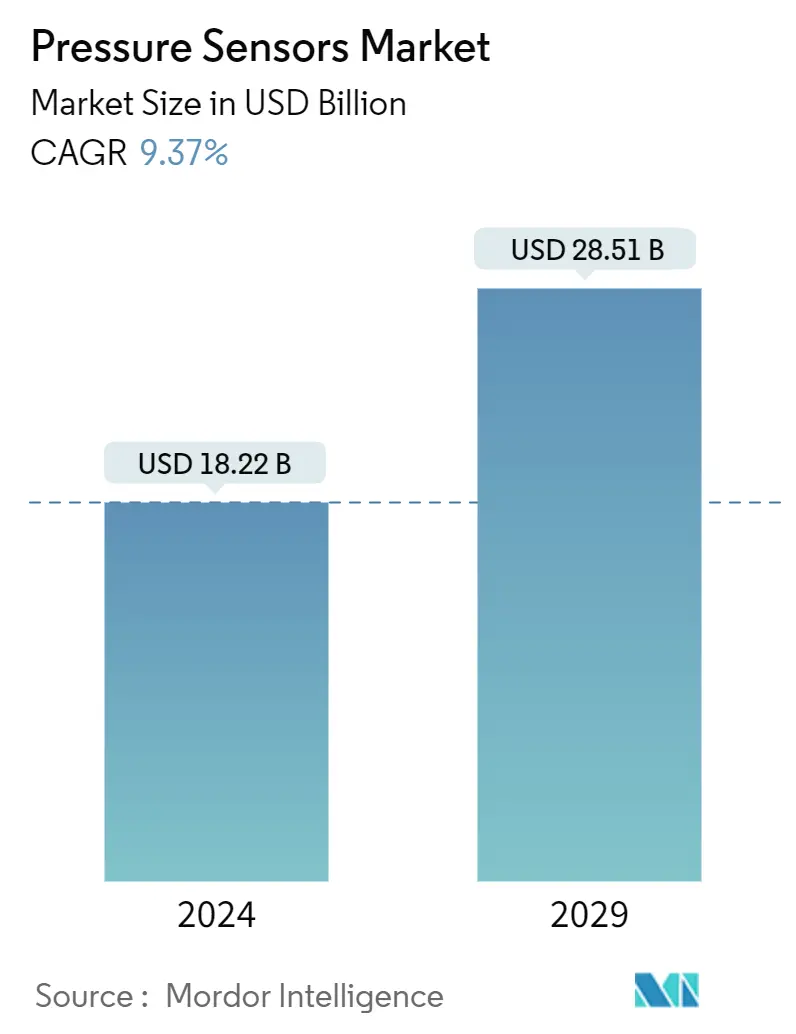
| Study Period | 2019 - 2029 |
| Market Size (2024) | USD 18.22 Billion |
| Market Size (2029) | USD 28.51 Billion |
| CAGR (2024 - 2029) | 9.37 % |
| Fastest Growing Market | Asia Pacific |
| Largest Market | Asia Pacific |
Major Players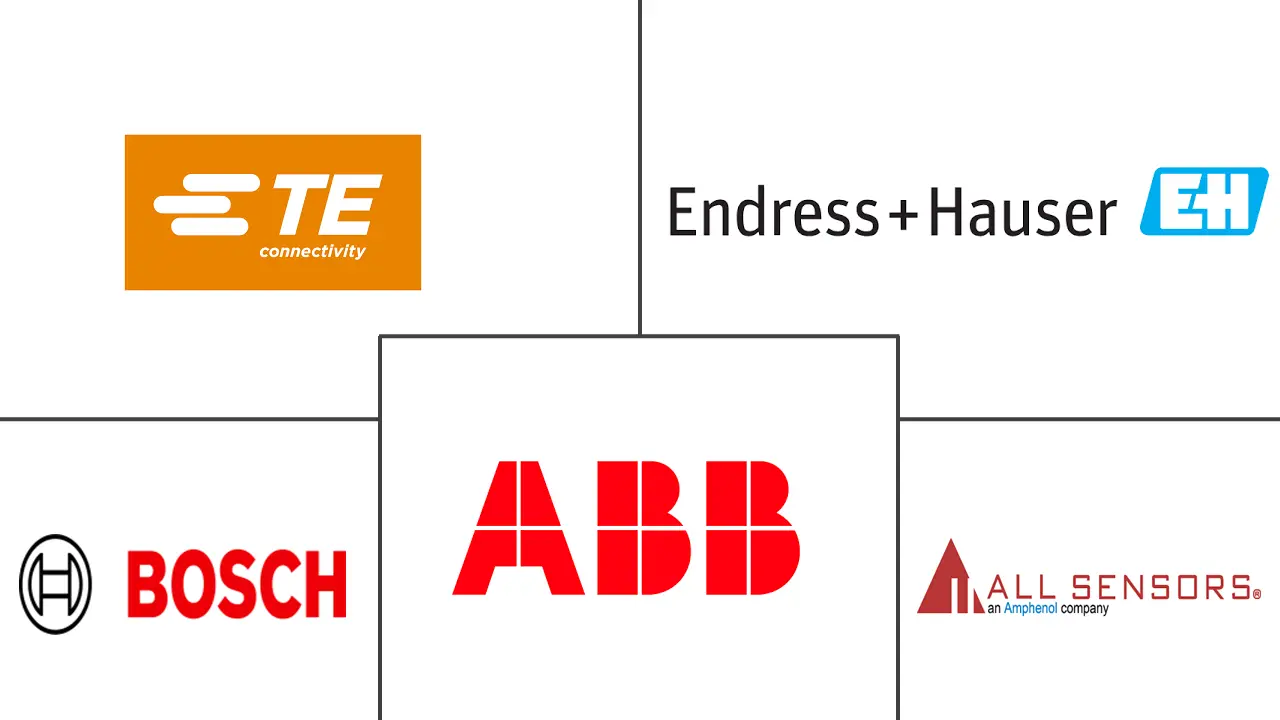
*Disclaimer: Major Players sorted in no particular order |
Pressure Sensors Market Analysis
The Pressure Sensors Market size is estimated at USD 18.22 billion in 2024, and is expected to reach USD 28.51 billion by 2029, growing at a CAGR of 9.37% during the forecast period (2024-2029).
- A pressure sensor is a device equipped with a pressure-sensitive element that measures the pressure of a gas or a liquid against a diaphragm made of stainless steel, silicon, etc., and converts the measured value into an electrical signal as an output.
- Gathering and collecting continuous data on static and dynamic pressure changes is vital for most manufacturing units and industrial institutions and for the proper operation of many consumer products. Overpressure could cause issues such as deterioration and negative shifts of outputs and generally harm the normal performance of applications. In recent years, pressure sensors have turned digital, miniaturized, lower-cost, and lower-powered, thus positively impacting its revenue surge. These changes have increased sensor efficiency and performance, generating a new wave of innovation.
- There are many different types of applications for pressure sensors, which create a need for a wide variety of sensor types and characteristics. Variants are available for harsh or corrosive environments and are aimed at high-integrity applications. For instance, in the last couple of decades, automotive has been one of the main sectors to drive demand for these devices. Companies that manufacture sensors for this industry must often maintain certification under IATF 16949, ISO 21750:2006, ISO 1550-2:2012, ISO 26262, and others. Pressure sensors in the automotive industry must also meet the requirements of ISO 1142-4 for resistance to electrical interference.
- The market's growth is attributed to the increasing demand for vehicle safety features, rising government regulations, and the growing automotive industry. With strict safety regulations coming into existence, the role of pressure sensors is expected to strengthen as designers use automotive pressure sensors primarily in three application areas: engine optimization, emission control, and safety enhancement.
- The market for sensors is getting diverse and growing, with design engineers packing more sensors into everything from automobiles to smartphones and applying them in new applications like smart toothbrushes and cat litter boxes. As sensors proliferate, concerns over cost continue to preoccupy engineers. The high costs associated with sensing products are expected to hinder the growth of the market.
- In the post-COVID-19 scenario, the start of 2022 was crucial as well as highly difficult for the global consumer electronics market due to numerous factors. For instance, the impact of the war in Ukraine and runaway inflation led consumer sentiment to plummet across the board. Additionally, in spring 2022, there were lockdowns in the largest sales market, China, which further negatively impacted sales. Notably, the football World Cup in the fourth quarter was expected to offer an opportunity to compensate for the weak first half of the year, but experience has shown that major events such as increased demand, particularly for TVs. However, given the poor consumer sentiment, this effect was not big enough to keep sales in the consumer electronics market from decreasing during 2022 overall.
Pressure Sensors Market Trends
Automotive is Expected to Hold Significant Share
- The pressure sensors in the automotive sector are driven by major factors such as tire pressure, brake fluid pressure, vapor pressure in the fuel tank, fuel injection and CDRi, and manifold absolute pressure, among others, which create application opportunities.
- For a long time, pressure sensors have been extensively utilized in various industries, including the automobile sector, to gauge the pressure of crucial fluids such as engine oil, gearbox and transmission oil, and hydraulic oil in braking, cooling, and fuel systems. The automotive industry offers diverse pressure sensor alternatives as it undergoes technological advancements to enhance safety, comfort, and entertainment. The compact size of these sensors has significantly influenced their widespread adoption in automotive design.
- Moreover, pressure sensors are utilized in electric vehicles to prevent finger entrapment indoors. Additionally, most electric vehicle cooling systems strive to maintain battery packs at their optimal operating temperature for extended periods. As automakers endeavor to incorporate battery packs with greater capacity in electric vehicles, the requirements for these cooling systems to manage such demands are also escalating.
- Therefore, pressure measurement has emerged as a crucial factor in the liquid cooling system of an electric vehicle. Pressure sensors play a pivotal role in providing feedback for regulating and optimizing the cooling system and detecting pressure loss that may indicate leakage. With the increasing complexity of liquid cooling systems, the need for precise and resilient pressure sensors for electric vehicle cooling systems is anticipated to be higher than ever.
- Microelectromechanical systems (MEMS) sensors are utilized for pressure sensing and as an air mass flow sensor. Technological advancements have led to the development of more compact and battery-free tire pressure sensor modules. MEMS-based energy harvesting systems are currently integrated into tires to reduce module size.
- The increasing sales and production of electric vehicles necessitate pressure sensors for various applications, including battery cooling fluid and vapor detection. As per the IEA, electric vehicle sales will constitute approximately 65% of total car sales by 2030 in the Net Zero Scenario. Such rising EV sales will create demand for pressure sensors.
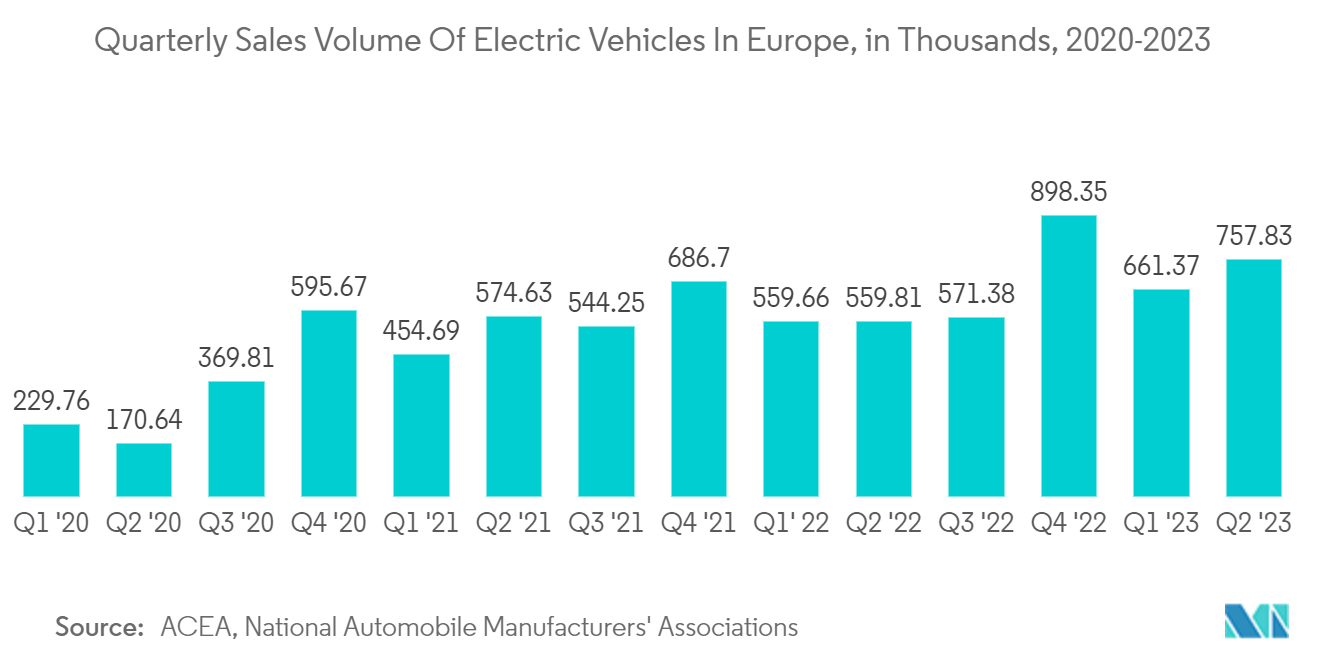
Asia Pacific to Dominate the Market
- China presents a highly promising market for the global medical industry, characterized by vast size, diversity, and growth potential, driven by a confluence of government backing and evolving demographics. Furthermore, with an increasingly elderly populace and heightened demand for superior medical equipment, the government has prioritized developing the healthcare sector, serving as a key impetus for the market.
- Pressure sensors are utilized in medical devices to oversee the pressure within the chamber and regulate the pressure level administered during treatment. China is a prominent global hub for medical device manufacturing.
- As per the National Medical Products Administration, the number of medical device companies in China reached 32,632 by December 2022, exhibiting a steady growth from 13,000 in 2008. Most of these companies, over 90%, are small and medium-sized enterprises. Such significant capabilities will enhance the application opportunities for the pressure sensors in the region.
- The automotive industry in Japan is the third-largest producer of automobiles globally, boasting 78 factories across 22 prefectures. Major companies such as Toyota, Kei, and Nissan contribute significantly to the country's economy, with automotive manufacturing accounting for 89% of the transportation machinery industry.
- Additionally, the growth of auto parts suppliers has become a substantial component of Japan's economy. Such significant automotive capabilities will create the demand for pressure sensors for various applications, such as to gauge the pressure of crucial fluids such as engine oil, gearbox and transmission oil, and hydraulic oil in the braking, cooling, and fuel systems. The region's progress in augmenting electric vehicle (EV) sales is also anticipated to stimulate market demand.
- Pressure sensors are utilized in HVAC systems to monitor the state of air filters. The rise in differential pressure across the filter can be detected as it becomes clogged with particulates. The demand for pressure sensors in India is estimated to rise due to the increasing demand for HVAC equipment. This demand is expected to accelerate due to the rapid construction of residential and commercial infrastructure, which is anticipated to expand as a result of the growing urban population in the region.
- The rising consumer electronics manufacturing, investments in the automotive industry, and developments in other sectors are expected to create the damned for pressure sensors in Asia-Pacific.
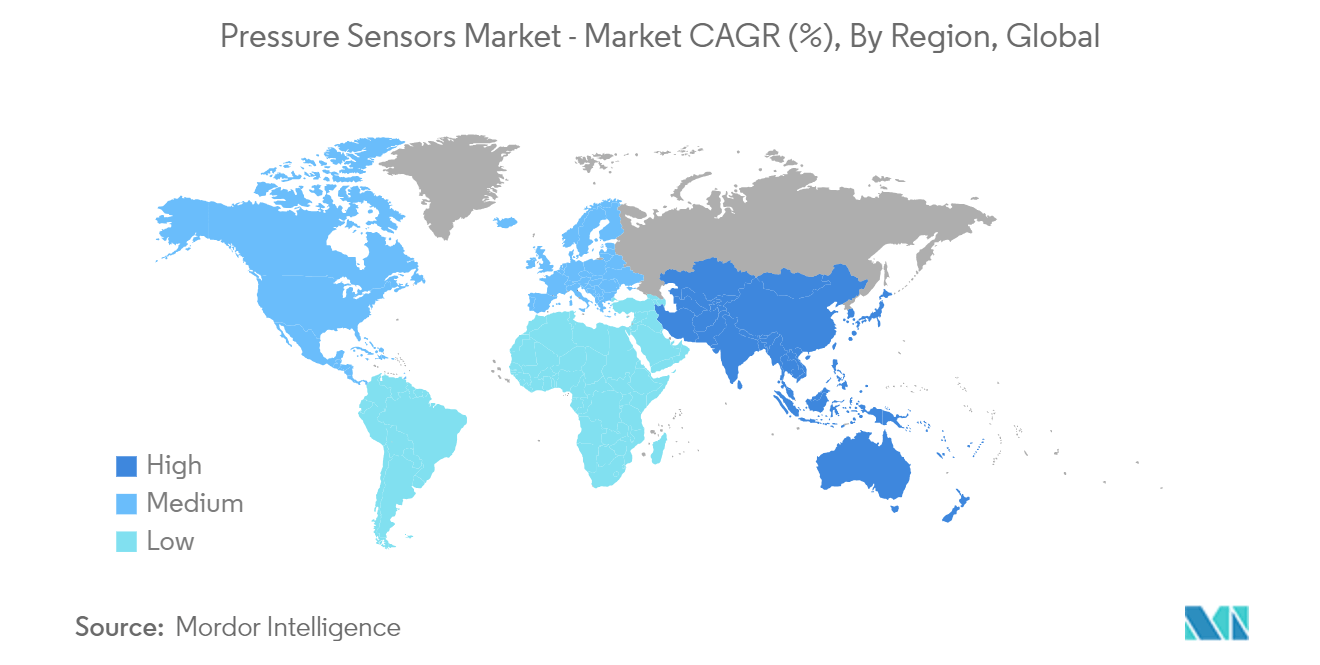
Pressure Sensors Industry Overview
The pressure sensor market is characterized by fragmentation and intense competition, with a presence of both domestic and international players. Technological advancements in the industry provide vendors with a sustainable competitive edge. Notable companies in this market include ABB Ltd., TE Connectivity, Endress+Hauser AG, Bosch Sensortec GmbH, and All Sensors Corporation.
In June 2023, Thermo Control, in partnership with Schneider Electric, implemented the Ecostruxure Building Management System (BMS) solution in a new factory constructed by IFM Prover in Sibiu, Romania. This system serves to monitor, control, and manage all electrical and mechanical installations within the factory. Additionally, the factory has integrated photovoltaic panels and heat pumps into the BMS solution, enhancing energy efficiency and reducing utility costs. Furthermore, the temperature, humidity, and pressure sensors utilized in the monitoring and control processes are manufactured within the IFM factory.
In January 2023, Bosch Sensortec unveiled a range of new sensors at CES 2023, including an AI-enabled sensor and a next-generation magnetometer. The newly introduced BMP585 barometric pressure sensors offer altitude tracking capabilities even in challenging environments, such as for wearables designed for swimming. These sensors boast ultra-low power consumption, ensuring extended battery life while delivering high accuracy and minimal noise levels.
Pressure Sensors Market Leaders
-
ABB Ltd
-
All Sensors Corporation
-
Bosch Sensortec GmbH
-
Endress+Hauser AG
-
TE Connectivity
*Disclaimer: Major Players sorted in no particular order
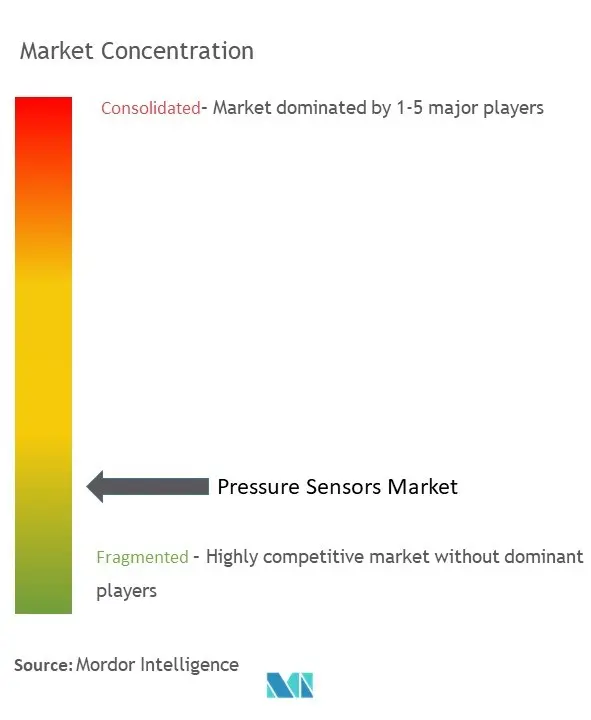
Pressure Sensors Market News
- June 2023: Infineon Technologies AG introduced two cutting-edge XENSIV barometric air pressure (BAP) sensors, the KP464 and KP466, with a primary focus on automotive applications. The KP464 sensor is meticulously engineered for precise engine control management, while the KP466 BAP sensor is tailored to enhance seat comfort functions.
- January 2023: Disrupt-X, a leading provider of IoT solutions, proudly unveiled its latest innovation: an advanced IoT solution designed for the continuous monitoring of air pressure within buildings. This pioneering IoT solution empowers real-time air pressure monitoring in industrial and commercial environments, offering invaluable data and insights to enhance safety, efficiency, and regulatory compliance. Leveraging IoT sensors, the Air Pressure Monitoring solution collects data on air pressure levels in designated areas or across entire facilities.
Pressure Sensors Market Report - Table of Contents
1. INTRODUCTION
- 1.1 Study Assumptions and Market Definition
- 1.2 Scope of the Study
2. RESEARCH METHODOLOGY
3. EXECUTIVE SUMMARY
4. MARKET INSIGHTS
- 4.1 Market Overview
-
4.2 Industry Attractiveness - Porter's Five Forces Analysis
- 4.2.1 Bargaining Power of Suppliers
- 4.2.2 Bargaining Power of Buyers
- 4.2.3 Threat of New Entrants
- 4.2.4 Threat of Substitute Products
- 4.2.5 Intensity of Competitive Rivalry
- 4.3 Industry Value Chain Analysis
- 4.4 Impact of Macro Trends on the Market
5. MARKET DYNAMICS
-
5.1 Market Drivers
- 5.1.1 Growth of End-user Verticals, Such as Automotive and Healthcare
- 5.1.2 Increasing Adoption of MEMS and NEMS Systems in the Industry
-
5.2 Market Restraints
- 5.2.1 High Costs Associated with Sensing Products
6. MARKET SEGMENTATION
-
6.1 By Type of Sensor
- 6.1.1 Wired
- 6.1.2 Wireless
-
6.2 By Product Type
- 6.2.1 Absolute
- 6.2.2 Differential
- 6.2.3 Gauge
-
6.3 By Technology
- 6.3.1 Piezoresistive
- 6.3.2 Electromagnetic
- 6.3.3 Capacitive
- 6.3.4 Resonant Solid-State
- 6.3.5 Optical
- 6.3.6 Other Pressure Sensors
-
6.4 By Applications
- 6.4.1 Automotive
- 6.4.2 Medical
- 6.4.3 Consumer Electronics
- 6.4.4 Industrial
- 6.4.5 Aerospace and Defense
- 6.4.6 Food and Beverage
- 6.4.7 HVAC
-
6.5 By Geography
- 6.5.1 North America
- 6.5.1.1 United States
- 6.5.1.2 Canada
- 6.5.2 Europe
- 6.5.2.1 United Kingdom
- 6.5.2.2 Germany
- 6.5.2.3 France
- 6.5.2.4 Rest of Europe
- 6.5.3 Asia-Pacific
- 6.5.3.1 China
- 6.5.3.2 Japan
- 6.5.3.3 India
- 6.5.3.4 Rest of Asia Pacific
- 6.5.4 Latin America
- 6.5.5 Middle East and Africa
7. COMPETITIVE LANDSCAPE
-
7.1 Company Profiles*
- 7.1.1 ABB Ltd
- 7.1.2 All Sensors Corporation
- 7.1.3 Bosch Sensortec GmbH
- 7.1.4 Endress+Hauser AG
- 7.1.5 TE Connectivity
- 7.1.6 Honeywell International Inc.
- 7.1.7 Schneider Electric
- 7.1.8 Kistler Group
- 7.1.9 Rockwell Automation Inc.
- 7.1.10 Emerson Electric Co.
- 7.1.11 Sensata Technologies Inc.
- 7.1.12 SIEMENS AG
- 7.1.13 Yokogawa Corporation
- 7.1.14 Infineon Technologies Ag
- 7.1.15 STMicroelectronics
- 7.2 Pressure Sensors Vendors - Market Share
8. INVESTMENT ANALYSIS
9. MARKET OPPORTUNITIES AND FUTURE TRENDS
** Subject To AvailablityPressure Sensors Industry Segmentation
The pressure sensor detects, measures, and transmits the information, which helps analyze the performance of a device. It uses IC fabrication technology made on silicon wafers, monitors and controls the pressure of gases and liquids, and measures different pressures, such as absolute, gauge, and differential pressure. Pressure sensors are used in numerous applications, which include medical, automotive, industrial, aerospace and defense, consumer electronics, food and beverage, HVAC, etc.
The pressure sensor market is segmented by type of sensor (wired and wireless), by product type (absolute, differential, and gauge), by technology (piezoresistive, electromagnetic, capacitive, resonant solid-state, optical, and other pressure sensors), by application (automotive, medical, consumer electronics, industrial, aerospace and defense, food and beverage, and HVAC) and geography (North America (United States, Canada), Europe (United Kingdom, Germany, France, Rest of Europe), Asia-Pacific (China, Japan, India, Rest of Asia Pacific), Latin America, Middle East and Africa). The market sizes and forecasts are provided in terms of value (USD) for all the above segments.
| By Type of Sensor | Wired | |
| Wireless | ||
| By Product Type | Absolute | |
| Differential | ||
| Gauge | ||
| By Technology | Piezoresistive | |
| Electromagnetic | ||
| Capacitive | ||
| Resonant Solid-State | ||
| Optical | ||
| Other Pressure Sensors | ||
| By Applications | Automotive | |
| Medical | ||
| Consumer Electronics | ||
| Industrial | ||
| Aerospace and Defense | ||
| Food and Beverage | ||
| HVAC | ||
| By Geography | North America | United States |
| Canada | ||
| By Geography | Europe | United Kingdom |
| Germany | ||
| France | ||
| Rest of Europe | ||
| By Geography | Asia-Pacific | China |
| Japan | ||
| India | ||
| Rest of Asia Pacific | ||
| By Geography | Latin America | |
| Middle East and Africa |
Pressure Sensors Market Research FAQs
How big is the Pressure Sensors Market?
The Pressure Sensors Market size is expected to reach USD 18.22 billion in 2024 and grow at a CAGR of 9.37% to reach USD 28.51 billion by 2029.
What is the current Pressure Sensors Market size?
In 2024, the Pressure Sensors Market size is expected to reach USD 18.22 billion.
Who are the key players in Pressure Sensors Market?
ABB Ltd, All Sensors Corporation, Bosch Sensortec GmbH, Endress+Hauser AG and TE Connectivity are the major companies operating in the Pressure Sensors Market.
Which is the fastest growing region in Pressure Sensors Market?
Asia Pacific is estimated to grow at the highest CAGR over the forecast period (2024-2029).
Which region has the biggest share in Pressure Sensors Market?
In 2024, the Asia Pacific accounts for the largest market share in Pressure Sensors Market.
What years does this Pressure Sensors Market cover, and what was the market size in 2023?
In 2023, the Pressure Sensors Market size was estimated at USD 16.51 billion. The report covers the Pressure Sensors Market historical market size for years: 2019, 2020, 2021, 2022 and 2023. The report also forecasts the Pressure Sensors Market size for years: 2024, 2025, 2026, 2027, 2028 and 2029.
Pressure Sensors Industry Report
The global market for pressure transducers is experiencing significant growth, driven by advancements in various sensor technologies and their increasing applications across multiple industries. The industry analysis highlights that the market size is expanding, with wired and wireless sensors playing a crucial role. The market segmentation by product type includes absolute, differential, and gauge sensors, each catering to specific needs within the automotive, medical, consumer electronics, industrial, aerospace and defense, food and beverage, and HVAC sectors.
Industry reports indicate that the market forecast shows a positive outlook, with market leaders continuing to innovate and capture significant market share. The market analysis reveals that piezoresistive, electromagnetic, capacitive, resonant solid-state, and optical technologies are at the forefront of this growth. The industry research underscores the importance of these technologies in enhancing the performance and reliability of pressure transducers.
Industry trends suggest that North America, Europe, Asia-Pacific, Latin America, and the Middle East and Africa are key regions contributing to the market value. The market overview and market review provide insights into the competitive landscape, highlighting the strategies adopted by leading research companies to maintain their market positions.
The industry information and industry statistics offer a comprehensive view of the market growth and market predictions, emphasizing the potential for further expansion. The report example and report pdf serve as valuable resources for understanding the market dynamics and future prospects. Market data and market segmentation are crucial for identifying opportunities and challenges within the market, while the market outlook and market overview offer a detailed perspective on the industry's trajectory.
In conclusion, the pressure transducer market is poised for continued growth, supported by robust industry research and market trends. The industry outlook remains positive, with significant contributions from various regions and technological advancements driving market expansion.



